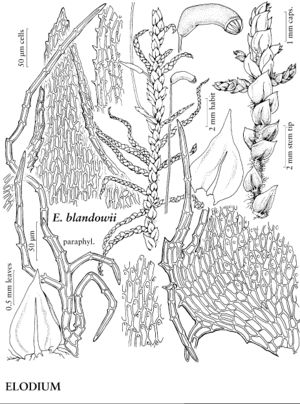Elodium
Musci Appalach., 52. 1870.
| Taxon | Illustrator ⠉ | |
|---|---|---|
 | Elodium blandowii | Patricia M. Eckel |
Plants medium-sized to large, green to yellowbrown. Stems erect or spreading, regularly ± 1-pinnate; paraphyllia filiform and narrowly lanceolate-foliose, branched or sometimes simple, cells long-rectangular, to 20: 1, smooth, apical cell-walls thin or somewhat thicker at tip; pseudoparaphyllia lanceolate-foliose, margins serrulate, proximal cells subquadrate, short to long-rectangular, smooth. Stem-leaves erect or erect-spreading, ovatelanceolate to rounded-cordate; margins irregularly revolute proximally or strongly, broadly or narrowly revolute to apex, entire and minutely toothed near apex, or denticulate throughout; apex abruptly to gradually narrowed, acumen broad or slender; costa surface smooth or with 1 or 2 teeth near insertion; laminal cells with abaxial surface roughened, 1-papillose centrally over lumen or more often near distal ends, papillae small, delicate; medial cells elongate; apical cell 6–7: 1, variously somewhat thickened distally, sometimes with one low papilla. Branch leaves similar. Sexual condition autoicous; perichaetia inner leaves cilia absent. Seta 2–6 cm. Capsule with stomata present in neck. Spores (10–) 11–15 (–16) µm.
Distribution
North America, Eurasia
Discussion
Species 3 (3 in the flora).
Elodium is distinguished from species of Thuidiaceae by its 1-pinnate branches with narrowly tapering branch ends. The marginal laminal cells in the often twisted acumen of species of Elodium are shorter than the cells mid acumen and produce a smooth, short apical cell. The basal laminal cells are larger, laxer, and paler than the more distal cells; in Echinophyllum they are thick-walled and short-rectangular to (sub)quadrate and concolorous. The perichaetial leaves of Elodium are nearly smooth throughout and bordered by minute, uniform denticulations, or sharply, distantly and irregularly toothed from distal cell ends. In Echinophyllum, the margins are sparsely short-ciliate with hyaline, long-celled, narrow teeth composed of (1 or) 2 elongate cells, free but parallel to the edge of the lamina. Both Elodium elodioides and E. paludosum seem intermediate in habitat preferences and able to tolerate seasonal desiccation.
Selected References
None.
Lower Taxa
Key
| 1 | Stems with central strand absent; stems closely, evenly pinnate, branches nearly equal; leaf apices short-acuminate; setae 4-6 cm; capsules 3-4 mm; paraphyllia to 27 cells in length. | Elodium blandowii |
| 1 | Stems with central strand present; stems loosely subpinnate, branches unequal; leaf apices long-acuminate; setae 2-2.8 cm; capsules 2-2.5 mm; paraphyllia 7-11 cells in length | > 2 |
| 2 | Leaves broadly cordate-ovate; apices abruptly acuminate; laminal cell walls thick, especially in margins, abaxial surface strongly 1-papillose centrally or nearer distal ends of lumen; leaf costa proximal abaxial surfaces with 1 or 2 scattered teeth. | Elodium elodioides |
| 2 | Leaves ovate-lanceolate; apices gradually acuminate; laminal cell walls thin, especially in margins, abaxial surface smooth or weakly papillose-prorulose; leaf costa proximal abaxial surfaces smooth. | Elodium paludosum |